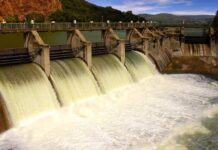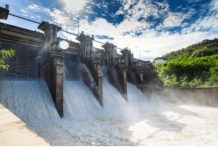The plant is being operated by Ertan Hydroelectric Development Corporation (EHDC). EHDC also owns other plants including the Yalong River Valley, Jinping Hydroelectric project, Guandi Hydroelectric project, Tongzilin Hydroelectric project and Lianghekou Hydroelectric project in China. Ertan is the only plant currently in operation. The others are in various stages of development.
The site is located near Panzhihua on the Yalong River (a tributary of the Yangtze) in Sichuan province. Sichuan is a mountainous inland province in the south west of China with excellent hydro potential. Its development was a top priority for the government, since the region is poor and attracting foreign investment had proved difficult compared to the successes of the booming coastal provinces.
Project
The gross capacity of the plant is 3,492MW (3,300MW net), well ahead of all other hydro projects of the time. The total investment was an estimated $3.4bn. In addition to the large local work force, the project has involved 700 technicians and specialists from the 47 countries involved.
The project has involved 700 technicians and specialists from 47 countries.”
China has the largest untapped hydropower potential in the world. As of 2008, China has a total installed capacity of 170GW from all large and medium-sized hydro power plants.
China produced about 430bkwh of hydroelectric energy in 2007 and was the largest producer of hydro power in the world during the same year.
Ertan is the largest project contributing to this total. The 1,517km-long Yalong River is an excellent site because of its drop of more than 4,400m and potential to produce 33,400MW.
Arch dam and powerhouse
The main project components are a concrete double-curvature arch dam (240m high and 775m long) and a huge underground powerhouse complex. The underground complex includes a powerhouse cavern (281m x 26m to 31m x 66m) with six 550MW units, a transformer cavern (215m x 19m x 25m) and a surge chamber (201m x 19m x 69m). The project also has the two largest diversion tunnels in the world (1,000m x 20m x 23m), two spillway tunnels (each 850m x 13m x 13.5m) and a 500m-long bridge.
The contract for all underground works and related structures was awarded to a German-Chinese joint venture under the leadership of Philipp Holzmann, Germany. The other partners are Hochtief, Germany, and Changjiang Gezhouba Engineering Bureau, China. Austria’s Geoconsult provided consultancy advice following fatal rockburst accidents during the underground construction work that were caused by stresses in the hard and brittle rock.
Generating units
Ertan was China’s first hydropower plant to be built through international bidding. Canada’s General Electric Co (GE) won the contract for the manufacture of the six generating units.
“Ertan was China’s first hydropower plant to be built through international bidding.”
The contract called for GE to manufacture the first two 582MW Francis turbines in Canada. The third and fourth was a joint project of GE and Harbin Electrical Machinery Works in northeast China’s Heilongjiang Province, and the Shanghai-based Dongfang Electrical Machinery Works. The fifth and sixth were produced by the Chinese firms alone.
Dongfang in particular is an important partner for GE. In September 1999, Ertan unit five, the first Chinese domestic-made 550MW hydropower generator, went into formal operation.
Dongfang and Harbin have also formed a joint venture company with Austria’s VA Technologie for domestic hydro turbine production.
Suppliers
Impregilo of Italy and Lyonnaise des Eaux of France also won joint venture construction contracts worth around $600 million. Mitsubishi Heavy Industries supplied switchgear. Harza Engineering, Lahmeyer International, Electricité de France and the Advisory Group of Norway provided consultancy services. Harza’s contract included design review, construction planning, cost estimates and tender evaluation services. Siemens provided a Chinese language version of its BFS plant management system for the Ertan plant, its first implementation in a hydro plant.
SMEC, Australia, has developed procedures and corresponding computer software to optimise the operation of the Ertan hydropower plant. The software package includes a generation management system (GMS) that operates with the Sichuan power grid. The power station operators, EHDC, will use ETGMS to optimise the operation of up to five hydro stations (including Ertan) for which it may be responsible in the future. The software simulates the operation of the entire Sichuan grid, with all existing and planned hydro and thermal generating plants. This allows EHDC to make the most of the water resources under its jurisdiction.
Financing
Ertan Hydroelectric Development Corporation’s (EHDC) profits from long-term contracted power sales to the local utility, Sichuan Electric Power, are being ploughed back into further hydro investment on the Yalong. This aims to start a cascade of developments, freeing new projects from some of the elaborate financing procedures required for Ertan.
“Financing involved substantial equity from EHDC’s three shareholders.”
Financing involved substantial equity from EHDC’s three shareholders: the State Development Investment Company, Sichuan Investment Company and Sichuan Electric Power Company.
Project loans came from the World Bank, the State Development Bank of China and domestic banks. The World Bank provided $780m in long-term loans and $150m in commercial loan guarantees.
The State Development Bank has used its government backing and high credit ratings to raise funds for Ertan and other infrastructure projects, including Three Gorges, in international bond and loan markets. The bank was founded in 1994 to overcome the limits faced by stretched domestic banks in high-capital-cost, long-term project lending.
Electricity consumption
There was some foreign scepticism at the start of the project over the potential electricity market in the region, and this may have some justification. Annual per capita power consumption in Sichuan is 600kW, which is less than 10% of that in the developed world.
The government of Sichuan province has however lifted its limits on electric power consumption and has begun encouraging local enterprises and urban consumers to use more electricity. Ertan plant managers are now concerned at the low take-up of available power.













































